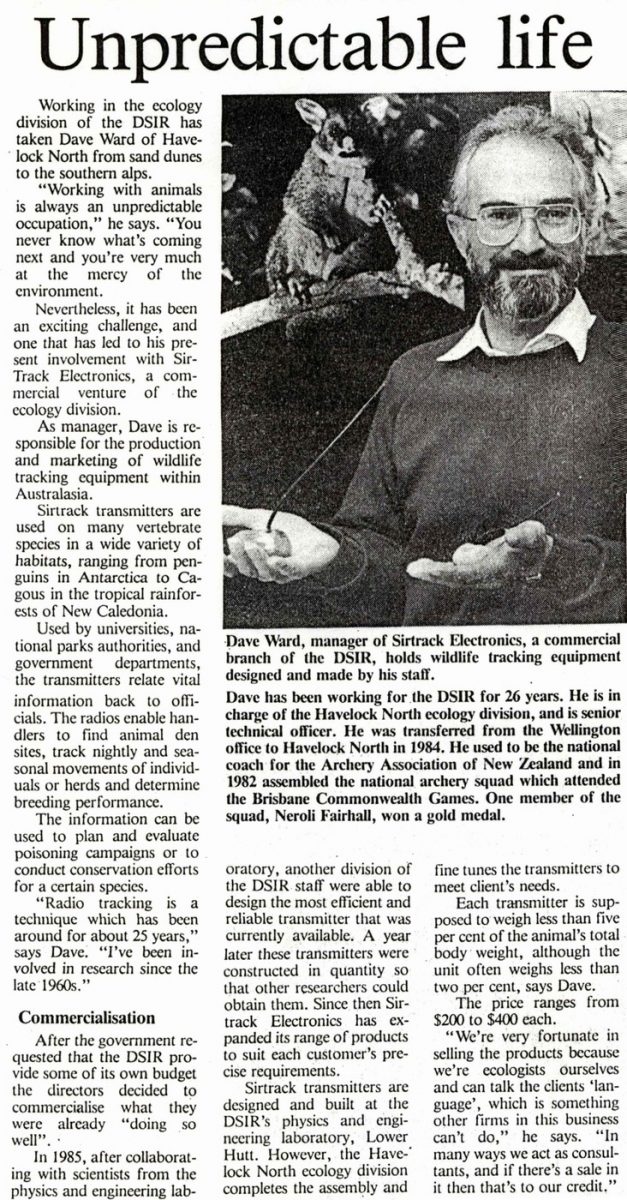Unpredictable life
Working in the ecology division of the DSIR has taken Dave Ward of Havelock North from sand dunes to the southern alps.
“Working with animals is always an unpredictable occupation,” he says. “You never know what’s coming next and you’re very much at the mercy of the environment.
Nevertheless, it has been an exciting challenge, and one that has led to his present involvement with Sir-Track [Sirtrack] Electronics, a commercial venture of the ecology division.
As manager, Dave is responsible for the production and marketing of wildlife tracking equipment within Australasia.
Sirtrack transmitters are used on many vertebrate species in a wide variety of habitats, ranging from penguins in Antarctica to Cagous in the tropical rainforests of New Caledonia.
Used by universities, national parks authorities, and government departments, the transmitters relate vital information back to officials. The radios enable handlers to find animal den sites, track nightly and seasonal movements of individuals or herds and determine breeding performance.
The information can be used to plan and evaluate poisoning campaigns or to conduct conservation efforts for a certain species.
“Radio tracking is a technique which has been around for about 25 years,” says Dave. “I’ve been involved in research since the late l960s.”
Commercialisation
After the government requested that the DSIR provide some of its own budget the directors decided to commercialise what they were already “doing so well”.
In 1985, after collaborating with scientists from the physics and engineering laboratory, another division of the DSIR staff were able to design the most efficient and reliable transmitter that was currently available. A year later these transmitters were constructed in quantity so that other researchers could obtain them. Since then Sirtrack Electronics has expanded its range of products to suit each customer’s precise requirements.
Sirtrack transmitters are designed and built at the DSlR’s physics and engineering laboratory, Lower Hutt. However, the Havelock North ecology division completes the assembly and fine tunes the transmitters to meet client’s needs.
Each transmitter is supposed to weigh less than five per cent of the animal’s total body weight, although the unit often weighs less than two per cent, says Dave.
The price ranges from $200 to $400 each.
“We’re very fortunate in selling the products because we’re ecologists ourselves and can talk the clients ‘language’, which is something other firms in this business can’t do,” he says. “In many ways we act as consultants, and if there’s a sale in it then that’s to our credit,”
Photo caption – Dave Ward, manager of Sirtrack Electronics, a commercial branch of the DSIR, holds wildlife tracking equipment designed and made by his staff.
Dave has been working for the DSIR for 26 years. He is in charge of the Havelock North ecology division, and is senior technical officer. He was transferred from the Wellington office to Havelock North in 1984. He used to be the national coach for the Archery Association of New Zealand and in 1982 assembled the national archery squad which attended the Brisbane Commonwealth Games. One member of the squad, Neroli Fairhall, won a gold medal.












Do you know something about this record?
Please note we cannot verify the accuracy of any information posted by the community.